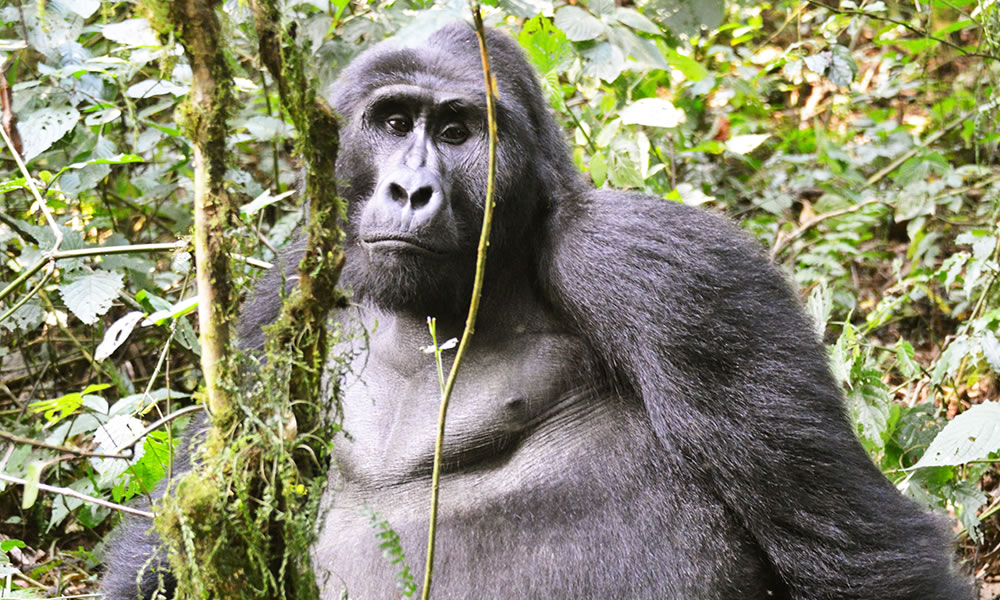Located in the three districts of Kanungu, Kabale, and Kisoro in South-Western Uganda, Bwindi Impenetrable National Park is recognised as a UNESCO World Heritage Site. The most popular tourist attraction in Uganda is Bwindi Forest National Park, which spans around 327 km2 and is located near to Virunga National Park and on the edge of the western Great Rift Valley. It shares a border with the Democratic Republic of the Congo. More over half of the 900 mountain gorillas in the world reside in Bwindi Forest National Park; the remaining gorillas are found in the nearby Virunga Ranges Mgahinga National Park in Uganda, Virunga National Park in the Democratic Republic of the Congo, and the Volcanoes National Park in Rwanda. With over 20 habituated gorilla families, the Bwindi Impenetrable National Park is the most popular place for tourists wishing to undertake gorilla trekking in Uganda.

Activities in Bwindi Forest National Park
Gorilla Trekking
The most exciting thing to do in Bwindi Impenetrable Forest National Park is go gorilla trekking; it’s an exciting activity that’s worth your time. Over 36 gorilla families can be found in Bwindi Impenetrable Forest National Park, but only 20 of these families are habituated to gorilla trekking. Gorilla trekking typically begins in the early morning with a briefing about the dos and don’ts while trekking gorillas. Mountain gorilla tracking in Bwindi Forest is conducted year-round, providing an exciting experience. You will get a rare opportunity to see several bird species, other primates like chimpanzees, white and black monkeys, red-tailed monkeys, and blue monkeys, butter flies, and tree species when gorilla trekking. You will spend an hour with the gorillas after your encounter, after which you will head back to Park headquarters. A gorilla trekking permit costs $800.00 per person for each trek, and in order to avoid disappointment, we strongly advise booking your permit at least five months in advance.
Gorilla Habituation
The Rushaga region is home to two gorilla families; the Bushaho and Bikyingi gorilla families, where gorilla habituation occurs. Gorilla habituation is a lifelong experience. A $1500 gorilla permit is needed in order to participate in such gorilla habituation activities. The journey costs per person and allows you to spend approximately four hours in their natural habitat, making it the most incredible experience in Bwindi Forest National Park. You can engage in this type of activity year-round, but we strongly advise you to secure your gorilla permit at least five months in advance of the date of gorilla habituation.
Hiking
Trekking through Bwindi Forest National Park provides an ideal opportunity to discover many sights within Bwindi Impenetrable National Park. These hikes typically take place from Bwindi’s north to south, where you can observe a variety of primates and bird species and come to appreciate Bwindi Forest Park’s natural surroundings along a variety of trails, including those that lead along rivers, lakes, Rushura Hill, Mubwindi Swamp, and many more.
Batwa Cultural
The Batwa cultural experience will also demonstrate to you how they made use of caverns, tree-houses, and grass for their dwellings. Discover the sharing and communal life of the traditional Batwa village. The Batwa people tell fascinating and moving tales of their fascinating forest lifestyle. They also engage in weaving and other artistic crafts that they sell to tourists that come to admire their efforts in the Bwindi Impenetrable Forest and as a solace after the jungle.
Bird Watching
With over 348 bird species recorded there, Bwindi Impenetrable Forest is one of the best places in Africa for birdwatching. Visitors can expect to see 25 restricted-range species there, 23 of which are only found in the Albertine Rift and four of which are globally threatened: Pseudocalyptomena graueri, the African Green Broadbill, is vulnerable, among many other species.
Best Time to Visit Bwindi Impenetrable National Park
While gorilla trekking in Bwindi Impenetrable National Park is possible year-round, the optimum months to visit are June through August and December through February. This is a better season to go gorilla trekking because there is less rain. Although March through April and September through November are the wettest months for bird watching, it is typically foggy and cloudy during these months, which makes going on a gorilla hike challenging.
